Regular tasks can all too easily fade into the background with all that’s going on in your organization. But, the activities you perform over and over are some of the most important to your business. They’re your business processes.
Executing business processes is how you deliver value to your customers every day. Making them work well can make your business more successful.
Knowing how to model and enhance a business process is a key skill. It's fundamental to many improvement strategies. You can get a firm grasp of what your business processes are and what they do.
If you want to apply some of the best process management tools to help you run your business, let's get started.
What is a business process
Simply put, a business process is a series of steps to deliver something of value. The "something of value" is part of an organizational goal -- such as increased profit or a better product.
You can harness your business processes to better achieve your business strategy. So what distinguishes a business process from other concepts?
A business process can include steps to produce your product or to sell your product. It can also involve steps to perform equipment maintenance, training, or accounting. They don’t contribute to the bottom line, but they still fill a specific business need.
Let's take a look at the characteristics that make up a business process.
Characteristics of a business process
A business process is a set of steps that it is a regular part of your operations. In other words, it’s distinct from a project, which has a specific goal. After you achieve that goal, the project ends.
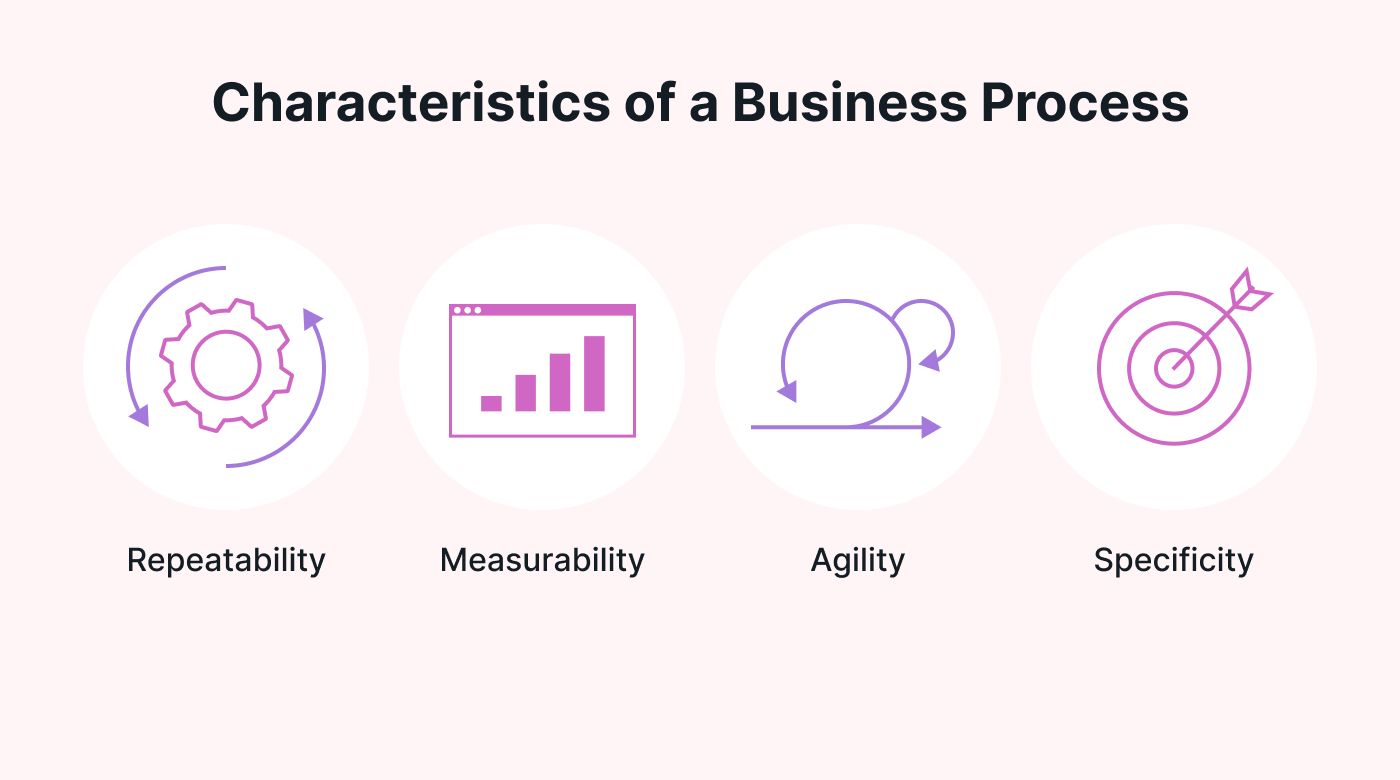 |
To qualify as a business process, a set of activities must have four characteristics:
- Repeatability - The work isn’t a one-off, but instead is a series of steps done again and again.
- Measurability - Use the right metrics to measure the performance of the process. The metrics have specific definitions and can apply only to certain steps or the whole process. Efficiency, productivity, cycle time, and throughput are examples of such metrics.
- Agility - The process can’t be too rigid. While it does have to be repeatable, it has to be adaptable to changing circumstances.
- Scope - A business process is clearly defined, in particular having a clear starting and end point.
Some might add a few other characteristics to qualify a set of activities as a business process:
- Purpose - The process has a reason for being -- performing it meets a business need.
- Result - Executing the process produces a product, service or other outcome.
- Consumer - Someone (or something) asked for and is waiting for the result. It could be another process, a customer, or other user of the result.
- Steps - Every process has specific steps produced by team members and / or some form of automation.
- Sequence - The steps are performed in a particular order, or a conditional order.
Business processes vs functions
Functions are areas of operations that are inextricably linked to each other. While functions aren’t the same as the departments of a business, they often map to each other. The accounting department, which balances budgets and manages assets, almost always performs accounting functions.
On the other hand, processes often include activities from several different functions. For example, the order fulfillment process may include steps performed by the production, shipping, and accounting functions.
Processes vs projects
Projects are distinct in a different way. While processes are a regular part of a business’s operations, a project has a specific beginning and end. It is perfomed once to deliver a product or service.
When a project finishes, it likely deploys some new or modified business processes. The internal or external users of its deliverables perform these new processes.
Why model business processes?
You probably already have a clear idea of how your business operates. So, why should you model your business processes?
Because modeling your business processes gives you the foundation to measure them in a concrete way. Once you have hard data, you can use it to analyze and manage the processes to improve your results.
Process analysis and process management approaches
Many process analysis and process improvement methods have been developed in recent decades. Some focus on improving or reengineering business processes. Others focus on removing variability in processes and minimizing defects.
Some use predictive analytics and simulation to identify waste and redundancy. Others specialize in robotic process automation. There are nearly as many methodologies as there are consultants that offer them. They may use different techniques, but they all have a similar purpose.
All these approaches offer ways to help organizations deliver more value and improve business outcomes. They focus on consistent, repeatable processes and seek to improve operations in specific and measurable ways.
Among the most widely used are Six Sigma and BPM, and those are the ones we’ll talk about here. They're not the same, and they're not mutually exclusive. Depending on your objectives, you might want to use more than one method for process improvement.
Six Sigma
Six Sigma is a widely used methodology for improving business processes by reducing or removing defects. Its roots lie in statistics with the bell-shaped or normal curve, and the concept of a standard deviation (represented by the Greek letter “sigma”).
Six Sigma began as a quality performance target, so a well-controlled manufacturing process would produce only 3.4 defects (or fewer) per million opportunities. It was originally used at Motorola in the 1980s to minimize variations in its manufacturing process so it could achieve close to “zero defects”.
Since then, Six Sigma has been adapted for other business processes. It's purpose is to find and remove causes of poor performance, and to reduce variability in business processes, such as supply chain management and healthcare process improvement.
The Six Sigma philosophy is to see all work as processes that can be improved using the five steps of Define, Measure, Analyze, Improve, and Control (DMAIC). More on DMAIC later.
While the purpose of Six Sigma is to reduce variation in processes and improve control of processes, Lean Six Sigma adds concepts from lean manufacturing to find and cut waste in processes. In other words, it combines removing waste in processes with the process improvement objectives of Six Sigma.
Lean Six Sigma also uses the five phases of DMAIC, but with more focus on refining or removing faulty or inefficient processes and functions.
Benefits of Six Sigma
Implementing Six Sigma can provide several important benefits.
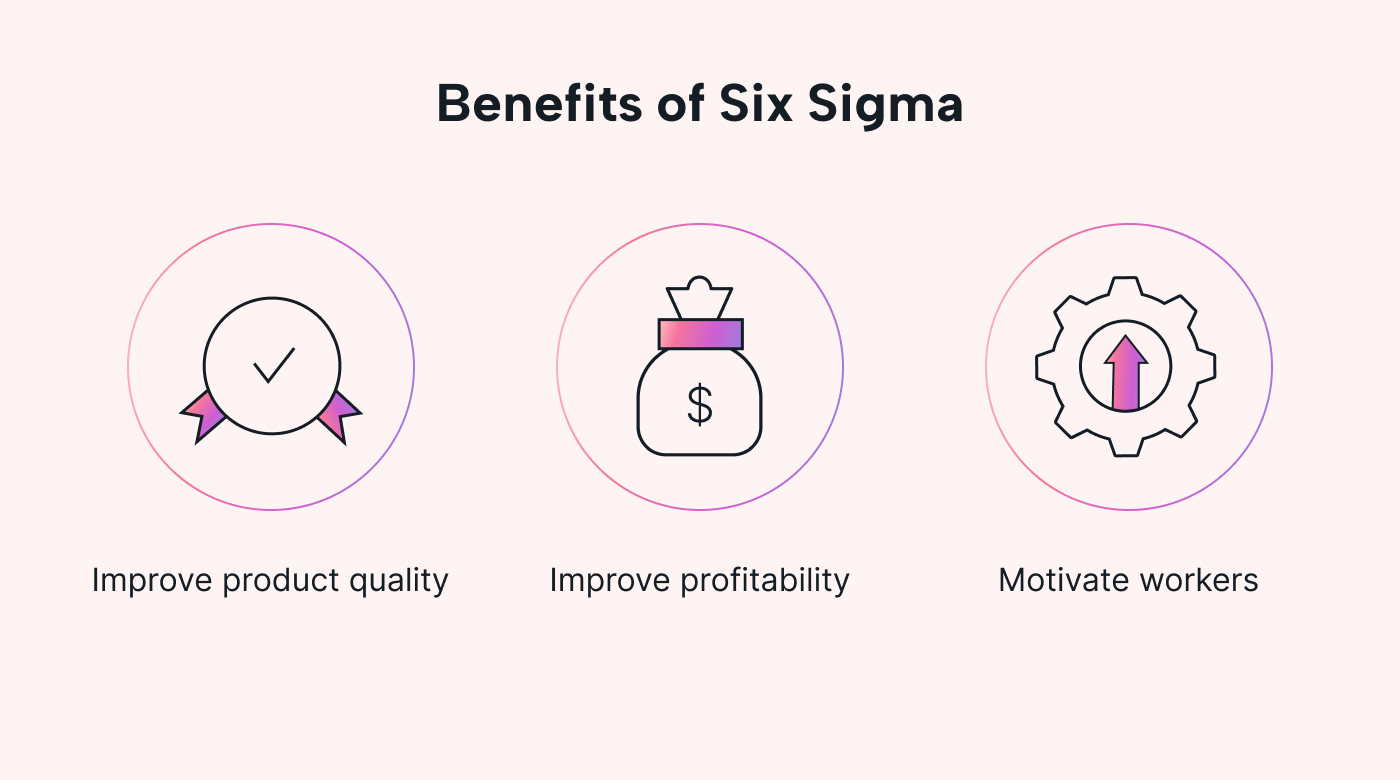 |
- Improve product quality - Reducing defects means customers will be more satisfied with your products, and in some industries will improve your compliance with standards and regulations. Reducing waste means you can reduce costs and boost productivity, too.
- Improve profitability - When your processes are more efficient and cost-effective, and your customers are happy, you improve your profitability.
- Motivate workers - To be successful, a Six Sigma program has to engage everyone in the organization. When you engage employees in process improvement and make them part of the process, they’re more likely to want better company performance..
Six Sigma Life Cycle
The rigorous Six Sigma methodology, known as the DMAIC methodology, is the most widely used by Six Sigma practitioners. The purpose of DMAIC is to find and remove the causes of variation to improve processes.
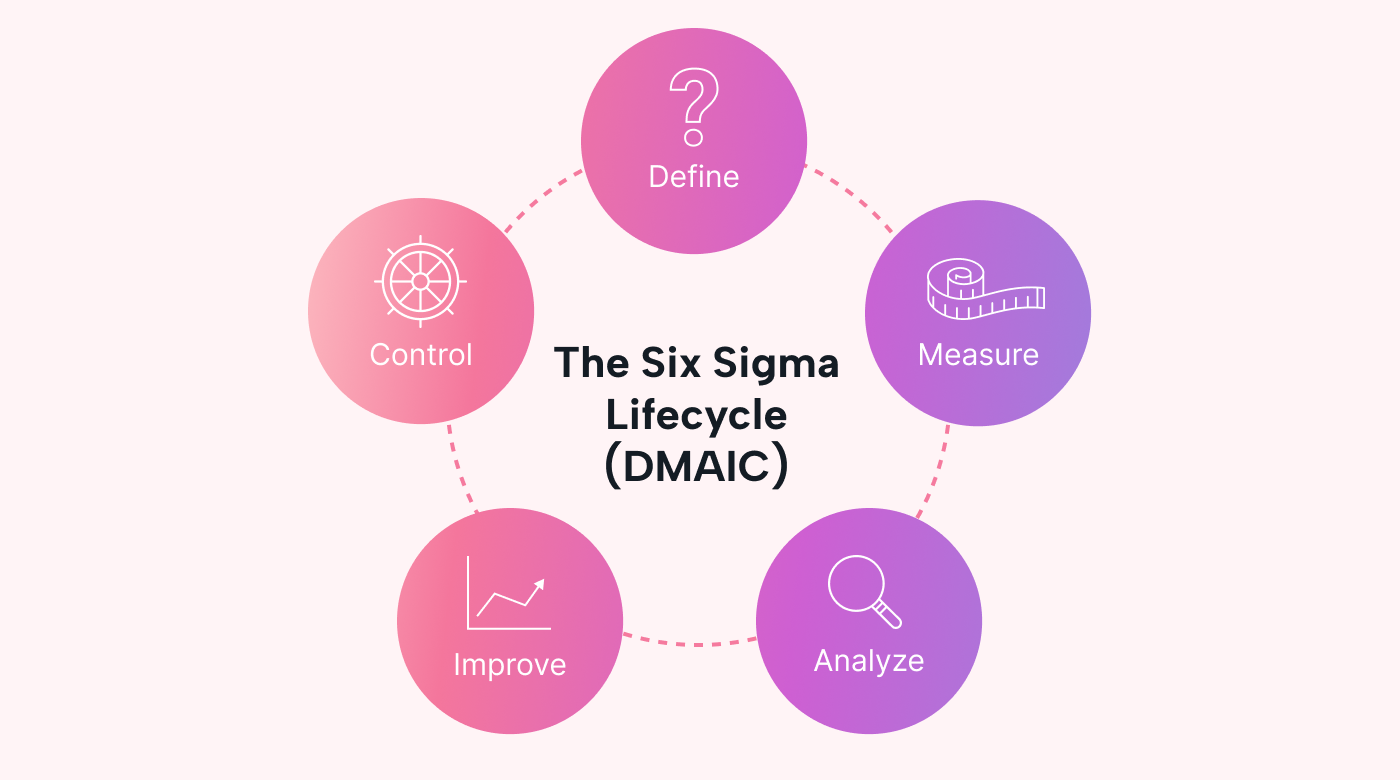 |
The Six Sigma (DMAIC) lifecycle has five phases: Define, Measure, Analyze, Improve and Control.
During each of the DMAIC phases, certain techniques are applied. For example, during the Define phase, the Voice of the Customer technique is used to help define the problem, and Root Cause Analysis / The 5 Whys may be used during the Analyze phase to get to the root cause of the problems being studied.
Along with the methodology and techniques, Six Sigma professionals use a set of tools. These tools include statistical process control (SPC), failure mode and effects analysis (FMEA) and process mapping, along with other tools.
Several organizations offer Six Sigma and Lean Six Sigma certification training, up through the “Master Black Belt” level. There are several types of Six Sigma processes, and different certification levels may be required for each type.
Look here for more about Six Sigma and Lean Six Sigma, and here for more about DMAIC.
Business Process Management (BPM)
While understanding business processes is important for a variety of disciplines, the primary purpose of BPM is to model and measure business processes, and then use the data to improve the processes so they better accomplish business goals.
In the most recent version of an bi-annual executive survey of organizations of all sizes and industries, 75% of respondents believe that BPM has helped their organizations achieve their goals.
Benefits of Business Process Management
BPM can provide several important benefits.
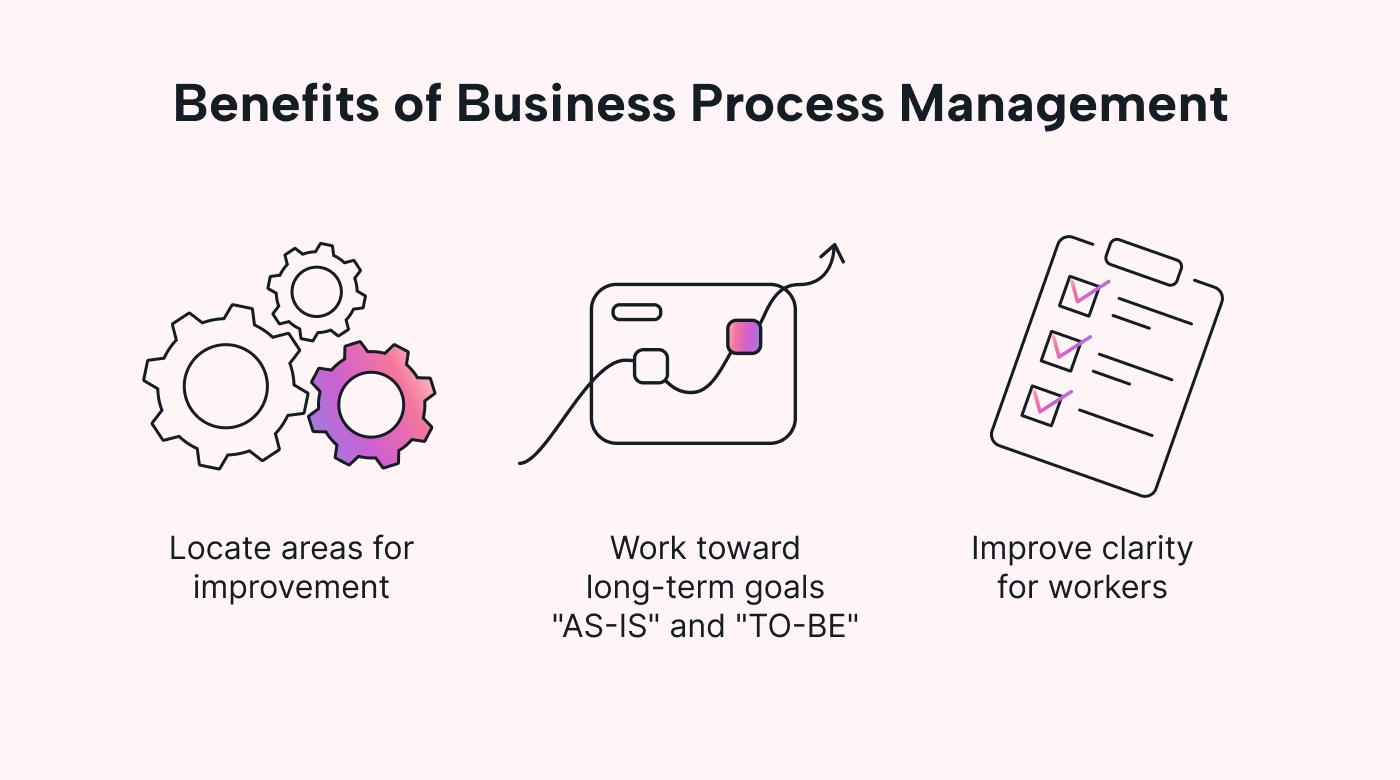 |
- Locate areas for improvement - With an understanding of your current business process flows, you can identify areas of potential improvement. You might be able to find ways to reduce costs, boost productivity, ensure compliance, or improve your customers’ experience.
- Work toward long-term goals - It’s much easier to plan for the future if you know where you stand right now (“as-is”). While small improvements might be obvious, you can also set bigger professional goals that you work toward over time, like gaining competitive advantage with new or better processes (“to-be”).
- Improve clarity - Clearly defining processes means that your workers know what to do to complete their tasks. Well-defined business processes also let you find opportunities to use business process automation. Software, AI, and business process automation tools can complete many tasks for you. Understanding processes can also cut down on the need for micromanagement.
As with Six Sigma, using BPM can remove process waste and defects, enhance your profitability, and improve employee engagement.
Business Process Management lifecycle
BPM gives you an organized method of understanding and improving business operations, by breaking them down into discrete processes.
The process characteristics we mentioned earlier, particularly measurability, play a large role in BPM. Much of the initial focus of BPM is on designing and mapping business processes, during which you’re collecting data on processes so you can accurately model them.
Process models may take several forms. They often use tools like flowcharts to visually represent a process flow. There are even specialized modeling notations for this purpose.
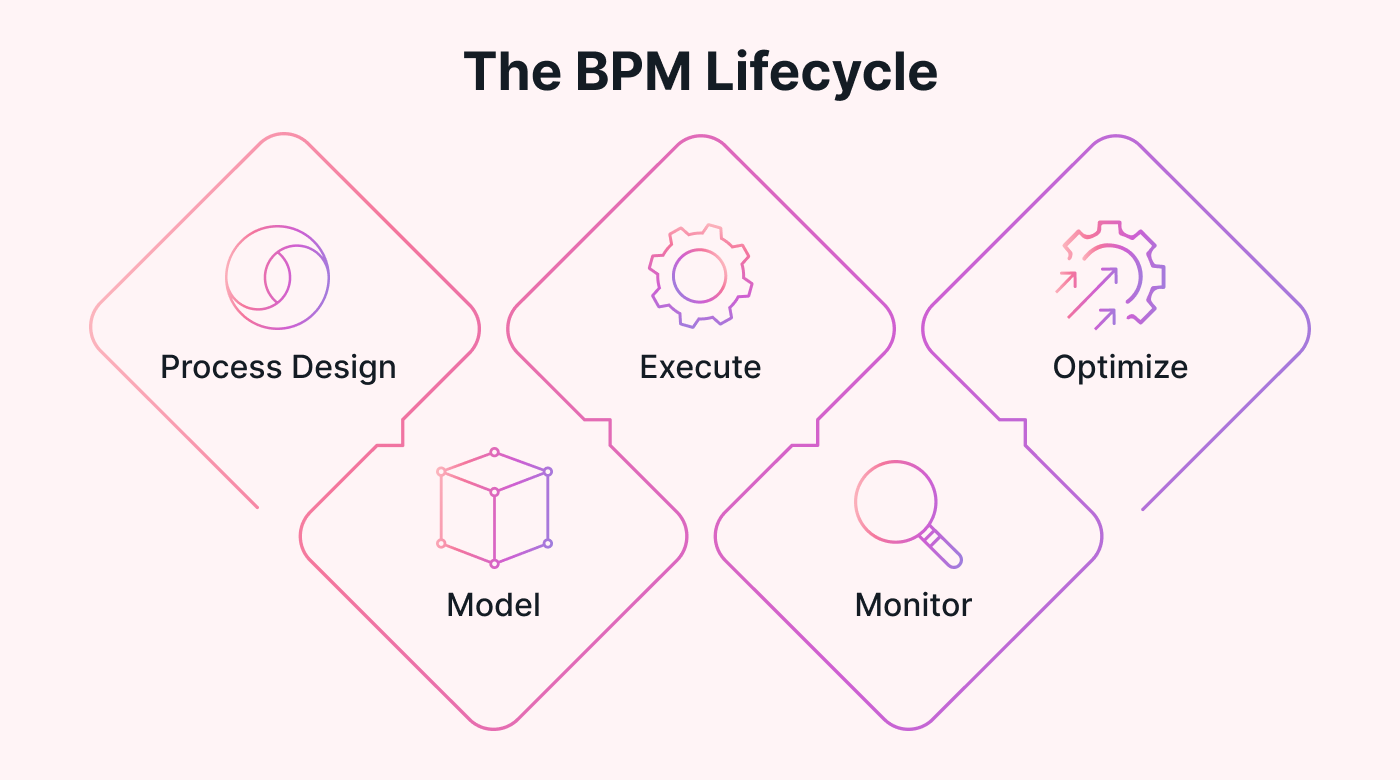 |
Traditionally, the BPM lifecycle has five major phases: process design, modeling, execution, monitoring, and optimization.
Not all approaches follow these five phases. Sometimes work begins with a separate step of reviewing the current process (rather than designing a new one). Others include a sixth step for reengineering when a total process replacement is needed. You should perform process analysis regularly as conditions change, to ensure that your processes remain efficient and useful.
Business process examples
The concept of business processes might be confusing in the abstract. It’s a very broad idea because it’s intended to fit a variety of different needs. However, a few examples can help clarify the idea. You can categorize processes in a variety of ways, but they’re often divided by what they deliver and whom they serve in a business.
One way of classifying business processes which we’ll use for the examples here is to separate them into:
- Operational processes
- Sales processes
- Supporting processes
- Management processes
Sales and operational processes are sometimes combined under the heading of core processes. Core processes are directly involved in delivering value to customers. Other categories might also fall under the heading of core processes.
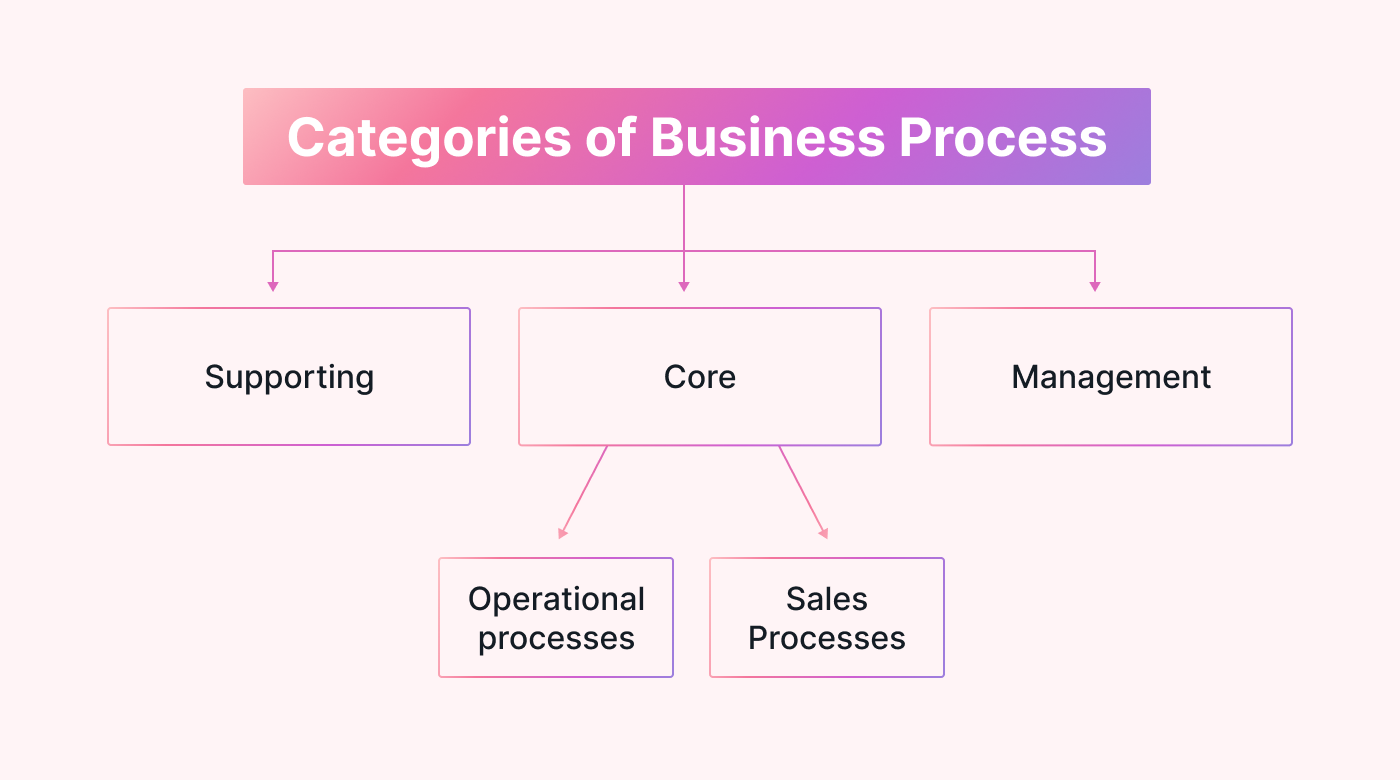 |
Supporting processes don’t directly produce profit, but they provide crucial support to the processes that do. They include such processes as finance, human resources, and research and development. Management processes direct both core and supporting processes.
Operational process example
Operational processes are often the heart of a business. They encompass all the ways a business produces its offerings, whether they are products, services or both. The simplest example of an operational process is manufacturing a product.
A manufacturing process might include activities such as:
- Sourcing parts or raw materials
- Assembling subcomponents into components
- Turning components or raw materials into a final product
- Transporting the product to a shipping center or customer.
Sales process example
Sales usually includes most client-facing processes. However, marketing and customer service processes might also be considered sales processes. A sales process might include activities such as:
- Generating sales leads
- Managing customer relationships
- Preparing proposals
- Transitioning sales into installations
Supporting process example
Supporting processes are often just as crucial to success as operations or sales, though they may get less recognition. They may include producing a budget, or keeping your facility clean. A classic example of a supporting process is human resources, which could include activities such as:
- Onboarding of employees
- Maintaining employee records
- Maintaining and communicating employment policies and practices
- Coordinating and providing assistance with employee benefits
Management process example
Management processes control the other types of processes. In addition to processes that directly involve managing operations, strategy development, investor relations and finance might also be considered management processes. Examples might include activities such as:
- Establishing strategic goals and objectives
- Setting and tracking performance goals
- Evaluating employee performance
- Making employment decisions
Getting started with business process improvement
Competition out there can be fierce. Managing your business processes well can give you a competitive edge. Once you identify a process, you can model it, measure it, and then improve it. By doing so, you’re taking the first steps toward making your business more efficient and successful.
For your process improvement projects or any other important projects on your list, let Motion help.
You can create, assign and prioritize tasks for all your projects. Motion’s AI can rearrange them based on your changing priorities and deadlines. And, it can automatically find time on everyone’s schedules for meetings.
Get moving with Motion to plan your process improvement initiative, and all the other projects on your list.






